A further evolution from the first (tracking) DAT was the NT-DAT. The advantage of this system is the much improved vibration and shock handling capacity. This technology was used in playback-only units such as car DAT players, but also in a miniature version, the so-called stamp-size DAT player. In the latter case, recording with the NT method was also applicable.
This technology never became a big commercial success, and is presently virtually at a standstill. The ideas and technology behind this design are still valid and can still be used, and for that reason they are still included in this edition.
NT playback
The original DAT specifications are based on the fact that each rec/pb head has its own azimuth and that each head must run correctly centered over the correct data track, for which purpose the automatic tracking following (ATF) system is included (see Section 15).
Whenever vibration occurs, there is the danger that the head loses track and that recovering the correct position immediately is impossible, resulting in loss of read-out or recorded data.
Non-tracking DAT does not use ATF tracking; in fact, there is no tracking at all. The combination of double density scan, high processor capacity and high memory capacity can overcome momentary loss of tracking.
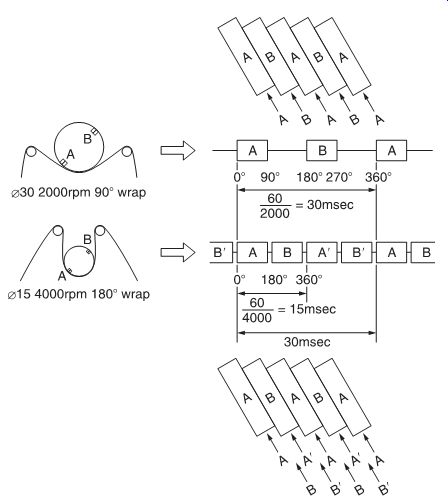
FIG. 1 Double density scan.
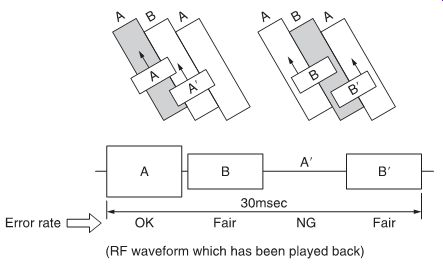
FIG. 2 Head versus tape.
Double density scan
FIG. 1 shows a comparison of playback waveforms obtained from a 30-mm diameter drum and a 15-mm diameter drum, respectively; however, the drum speed of the latter is 4000 rpm instead of the conventional 2000 rpm. On the other hand, the relative tape to head speed remains the same: In the case of the 15-mm drum, the wrap angle is 180°.
Each head will in this case perform read-out, but twice that of the 30-mm drum (the drum speed being doubled), and also not correctly over the centre of the track. The result on the RF level is shown in FIG. 2.
V30 2000 60 15 4000 60 3.1m/s r =×× =×× = pp
Depending on the azimuth of the head versus track, it is possible that some read-out is good, fair or not good at all, but in any case, all data will be read out at least once with sufficient RF level.
If the RF level becomes low, it is obvious that the error rate of the data will increase; this is recovered partly by the error correction and partly by the double read-out.
Another important detail is that the head width in conventional DAT players is 20 µm, whereas it is 28.5 µm in this type of player; more RF is therefore obtained.
In long-play mode, the drum speed will be the same and the tape speed will be halved. This results in a four-times read-out, thereby decreasing the error rate significantly.
NT read-out
As the data which are recorded on the tape contain address data (frame address and block address), it is possible to handle these data correctly even if they are retrieved in a non-logical or discontinuous sequence.
As shown in FIG. 3, when the tracking angle of the play back head deviates from the recorded track, the read-out order will be non-logical and maybe even discontinuous. This is not a problem because of the frame and block addresses of each data block.
Each data block that has been read out correctly will be stored in random access memory (RAM). After several head read-outs, all data blocks of each track will have been read out at least once and stored; if so, the data can be released.
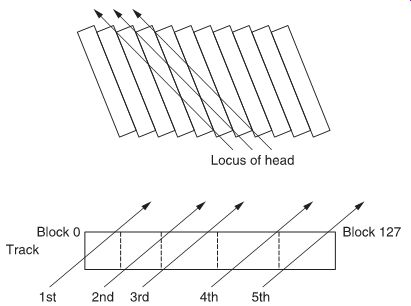
FIG. 3 Head locus.
FIG. 4 Track read-out.
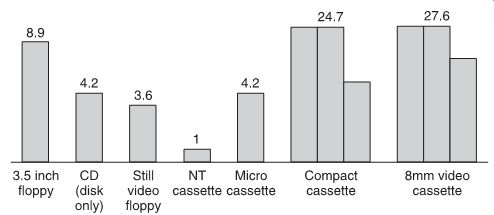
FIG. 5 Cassette size comparison.
It is obvious that the RAM capacity now becomes important. Supposing an RAM of 1 Mbit is used; this has a capacity of about 12 frames, or 24 tracks, as each frame consists of two tracks.
Each track contains 128 blocks of 32 symbols, and each symbol contains 8 bits, so each track represents 128 × 32 × 8 = 32 768 bits (or 32 kbit); 24 tracks represent 32 kbit × 24 = 768 kbit.
The difference between 768 kbit and 1 Mbit is needed for normal processing buffers, such as for error processing and others.
NT stamp-size DAT
NT stamp-size DAT is a miniature DAT format. The dimensions of the cassette are 30 mm × 5 mm and it weighs 2.8 g.
In this section we will review the essential differences between the conventional DAT and the stamp-size DAT (also referred to as Scoopman).
The size as compared with other types of cassette is extremely small, and yet it is a digital recordable medium allowing high quality. The sampling rate is 32 kHz, and quantization is 12-bit non-linear, which is comparable to a normal DAT recording in long-play mode.
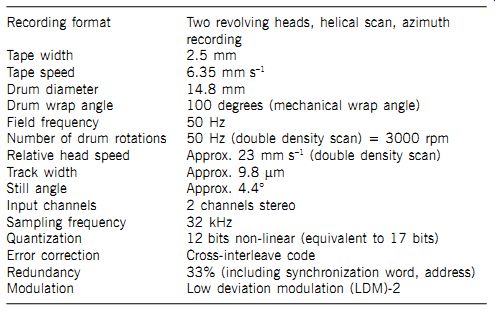
Table 1 General specifications for NT format

Table 2 Main specifications for NT recorder
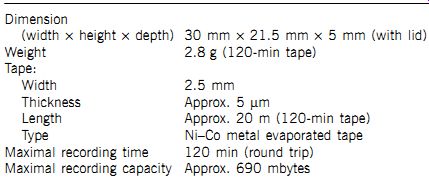
Table 3 General specifications for NT cassette
Double-sided, bi-directional use
Contrary to the conventional DAT type, the stamp-size type is bi-directional; in other words, it is used more like an analog cassette type which has to be reversed.
Tracks are divided into top and bottom halves. In the future, it will be possible to use a bi-directional turnaround mechanism, which, in combination with a large memory size, will enable a smooth, glitchless autoreverse operation.
The tape format is shown in Fig. 6; tape width is 2.5 mm, still angle of each track is approximately 4.4° and track pitch is 9.8 µm.
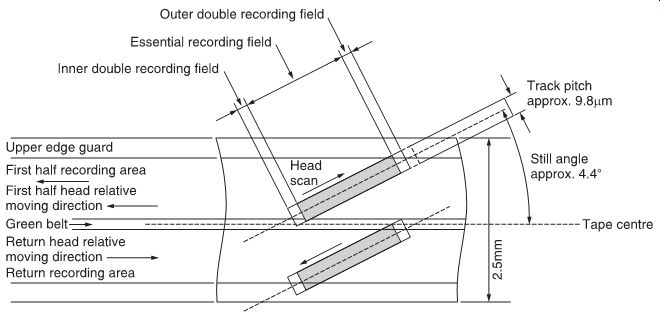
FIG. 6 Tape format.
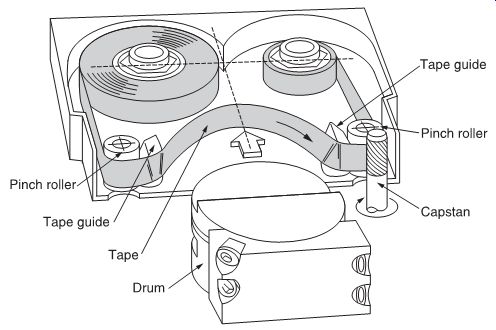
FIG. 7 Drum versus cassette.
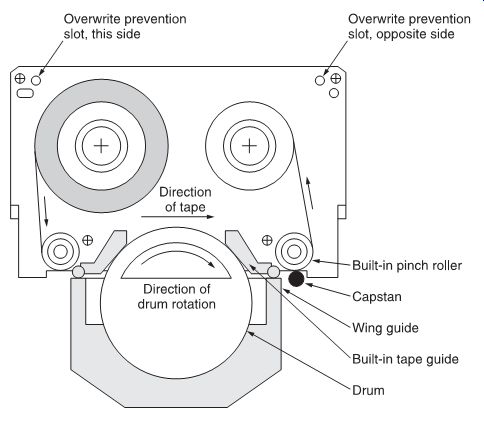
FIG. 8 Non-loading method.
Non-loading method
All the previously used drum-based systems are based on the idea that the tape has to be taken out of its cassette and wrapped around the drum.
In this case, however, the technology is reversed. The drum assembly will be inserted into the cassette (of which the front cover is tilted away). FIG. 7 shows the drum versus the cassette.
This solution allows a design which is much simpler, smaller and more cost-effective, as the loading mechanism is extremely simplified.
One of the major differences is that much of the technology which used to be built into the recorder/playback set is now built into each cassette itself. This also has a very positive effect on the wear of the set. FIG. 8 shows the non-loading method.
Each cassette contains built-in pinch rollers (also contrary to any conventional design). When inserting the drum into the cassette, the capstan, which is mounted on the same platform as the drum, will automatically be positioned against the pinch roller.
Each cassette also contains tape guides, so that the tape is automatically guided correctly over the inserted drum. Insertion of the drum assembly into the cassette can be performed automatically as well as manually.